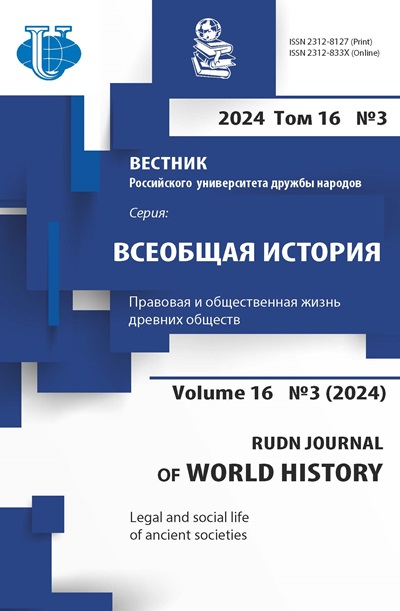The motif of chariot races in the Ionian art at the turn of the 6th and 5th centuries BC
- Authors: Nenakhova M.N.1
-
Affiliations:
- Lomonosov Moscow State University
- Issue: Vol 15, No 3 (2023): The Man of Antiquity in public and private life
- Pages: 330-339
- Section: RELIGION AND CULTURE
- URL: https://journals.rudn.ru/world-history/article/view/35950
- DOI: https://doi.org/10.22363/2312-8127-2023-15-3-330-339
- EDN: https://elibrary.ru/UUSYEV
Cite item
Full Text
Abstract
At the turn of the VI - V centuries BC in the funerary art and temple terracotta decoration of the cities of Asia Minor, the motif of chariot races appears. Moreover, these monuments demonstrate an impressive stylistic similarity. The author of the article tried to establish the reason for the persistent appeal to one plot by the Ionian masters in the cult and funeral spheres for a short period of time. Since the horse and chariot agons were associated with Poseidon, the author connects the mentioned plot with the sanctuary of Poseidon Heliconius at Cape Mycale. According to the hypothesis proposed by the author, chariot races were associated not only with the cult of Poseidon, but also with the Panionian games in honor of the god of the seas. This connection, according to the author, was reflected in the temple friezes depicting chariot races, which served as an important visual reference to the cult that united the member cities of the Ionian Union.
About the authors
Maria Nikolaevna Nenakhova
Lomonosov Moscow State University
Author for correspondence.
Email: Maria_nenahova@mail.ru
ORCID iD: 0000-0002-4178-6324
post graduate student in Department of General Art History
1, Leninskie Gory St, Moscow, Russian Federation, 119991References
- Nalimova NA. Sceny sostjazanij kolesnic v pogrebal’nom iskusstve IV v. do n.e.: Galikarnasskij i Verginskij frizy [Scenes of chariot races in funerary art of the 4th c. BC: friezes of Halicarnassus and Vergina]. DVAM. 2018; (9):159–179. (In Russ.).
- Walter-Karydi E. Die Athener und ihre Gräber (1000–300 v.Chr.). Berlin: Walter de Gruyter; 2015.
- Cook RM. Clazomenian sarcophagi. Mainz/Rein: Verlag Philipp von Zabern; 1981.
- Murray AS. Terracotta sarcophagi. Creek and Etruscan in British Museum. L.: The Trustees of the British Museum; 1898.
- Öncü E. Manufacturing techniques and production processed of the terracotta roof materials of Larisa (Buruncuk, Turkey). Deliciae Fictiles V. Networks and Workshops: Architectural Terracottas and Decorative Roof Systems in Italy and Beyond. 2019; (5): 37–48.
- Özyiğit Ö. Phocaean Horse and Griffon Protomes. In : S. Bouffier, A. Hermary, editors. L’Occident grec de Marseille à Mégara Hyblaea: hommages à Henri Tréziny. Aix-enProvence: Centre Camille Jullian, 2013, р. 15– 26.
- Ridgway BS. Notes on the Development of the Greek Frieze. Hesperia.1966; (35):188–204.
- Lapteva MJ. U istokov drevnegrecheskoj civilizacii: Ionia. XI–VI vv. do n.e. [At sources of ancient Greek civilization: Ionia XIth-VIth centuries BC]. Sankt Peterburg, Gumanitarnaja Akademija; 2009. (In Russ.).
- Cross ND. The Panionia: The Ritual Context for Identity construction in archaic Ionia. Mediterranean Studies. 2020; 28 (1):1–22.
- Katsonopoulou D. Further Insights on the Cult of Poseidon Helikonios in Helike (IV). In: HELIKE V : Ancient Helike and Aigialeia Poseidon, God of Earthquakes and Waters, Cult and Sanctuaries. Athens: The Helike Society; 2017, р. 17–34.
- Jellinskie pojety VIII–III vv. do n.e. Jepos, jelegija, jamby, melika [Hellenic poets of the 8th–3rd centuries BC. Epos, elegy, iambs, melika]. Ed. M.L. Gasparov. Moscow; 1999. (In Russ.).
- McPhail C. The Roles of Geographical Concepts in the Construction of Ancient Greek Ethno-cultural Identities, from Homer to Herodotus: An Analysis of the Continents and the Mediterranean Sea. (Thesis, Doctor of Philosophy). University of Otago, Dunedin, New Zealand; 2015.
- Nenakhova M. Clazomenian Sarcophagus from the British Museum: The Semantic Aspects of the Decoration and Shape. In: AV Zakharova, SV Maltseva, EU Staniukovich-Denisova, editors. Actual Problems of Theory and History of Art: Collection of articles. Vol. 11. St. Petersburg: St. Petersburg Univ. Press.; 2021, р. 38–46.













